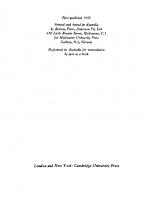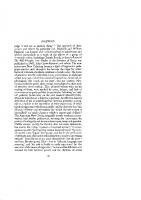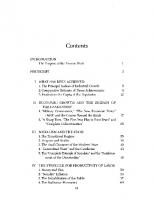The Catullan Revolution
251 64 2MB
English Pages [130] Year 1959
Recommend Papers

- Author / Uploaded
- Kenneth Quinn
File loading please wait...
Citation preview
The Catullan~olution BY
KENNETH SENIOR
QUINN
LECTURER
UNIVERSITY
MELBOURNE
IN CLASSICS
OF MELBOURNE
UNIVERSITY
PRESS
First published 1959 Printed and hound in Australia hy Brown, Prior, Anderson Pty Ltd 430 Little Bourke Street, Melbourne, C.1 for M elhourne University Press Carlton, N.3, Victoria Registered in Australia for transmission hy post as a hook
London and New York: Cambridge University Press
To Gamby
Preface
T
book deals mainly with literary criticism. Its object is to assess in general terms the shape of a new movement in poetry that began in Rome around Catullus, and the impact of that movement on the subsequent course of Roman poetry. The two best books on Catullus in English are A. L. Wheeler's Catullus and th,,:Traditions of Ancient Poetry and E. A. Havelock's The Lyric Genius of Catullus. The first is now thirty years old, the other twenty, and both have been long out of print. What I have to say has benefited, I hope, from Wheeler's great learning, while my first interest in Catullus (like that of many others) owes much to Havelock, whose book, despite some reckless generalizations, contains much responsive and perceptive criticism. But a good deal has happened in Catullan studies in twenty to thirty years, and a great deal more has taken place in the world of literature in general to change the outlook and standards of the literary critic. It would have been easy to multipiy references. I have tried to keep mine to works that seemed particularly important, or on which I have drawn directly for views that seemed to me novel. The reader who wants some assistancein finding his way more deeply into the literature on Catullus may profitably consult two recent and fairly full bibliographies: that of R. G. C. Levens in Fifty Years of Classical Scholarship, edited by M. Platnauer (1955), and J. Granarolo's excellent article, 'Ouen sont nos connaissancessur Catulle1' in L'information Utteraire, l 956, pages 56-65, which is well worth the little trouble it may take to get hold of it. More abundant references, many of them worth following up, will be found in L. Ferrero's Un' introduzione a Catullo (1955). This book began to take shape in my Roman Personal HIS
PR.EFACE
Poetry Seminar at Melbourne and was written in Cambridge while I was Commonwealth Fellow of St John's College. I am grateful to past members of the Seminar for suggestions and the stimulus they provided, while my particular thanks are due to Professor C. 0. Brink, Gonville and Caius College, Cambridge, Professor Thomas Gould, Amherst College, Mass., Dr R. D. Gray, Emmanuel College, Cambridge, and Dr F. R. Leavis, Downing College, Cambridge, for their help and encouragement, and above all to Mr A. G. Lee, St John's College, Cambridge, for detailed and valuable criticism freely given. Finally, but not in the place of least honour, my wife, for her constant support and not inconsiderable collaboration. The text used for the quotations from Catullus is that of R. A. B. Mynors, Oxford, 1958, by kind permission of Professor Mynors and the Delegates of the Oxford University Press. For convenience, in one corrupt line (Poem 6, 12) I have printed a traditional conjecture. Robert Graves's poem 'The Cool Web' is reprinted by kind permission of Mr Graves from Collected Poems 19141947, published by Cassell and Co. K.Q. Melhourne February 1959
Contents I
THE
BACKGROUND
1
The Hellenistic Background - 4 The Roman Background - 5 Roman Poetic Tradition before Catullus II
THE
TRADITION
7
RE-SHAPED
III
LEVELS OF INTENT
IV
THE CHARACTERISTICS NEW POETRY
19 27
OF THE 44
Did the Poetae Novi form a School? - 44 The Poetry of Youth and Reaction-48 The Poetry of Catullus: Its Underlying Unity- 50 Metre and Structure - 55 Language - 58 V THE CATULLAN VI THE BEGINNINGS
EXPERIENCE OF MODERN
70 LYRIC
85
The Poet's Audience- 87 Meditative Lyric - 90 Formal Survivals: The A'ddressee-95 NOTES
101
INDEX
117

![Catullan Provocations: Lyric Poetry and the Drama of Position [Reprint 2019 ed.]
9780520924093](https://ebin.pub/img/200x200/catullan-provocations-lyric-poetry-and-the-drama-of-position-reprint-2019nbsped-9780520924093.jpg)







